Drawings and schemes: How to find Lyra constellation
How to find Lyra constellation
"The ancient Egyptians believed that the drawings of the constellations are messages from the gods, you only need to learn how to understand them correctly."
Google translator 2021, JuLy, original text: How to find Lyra Constellation (Russian)
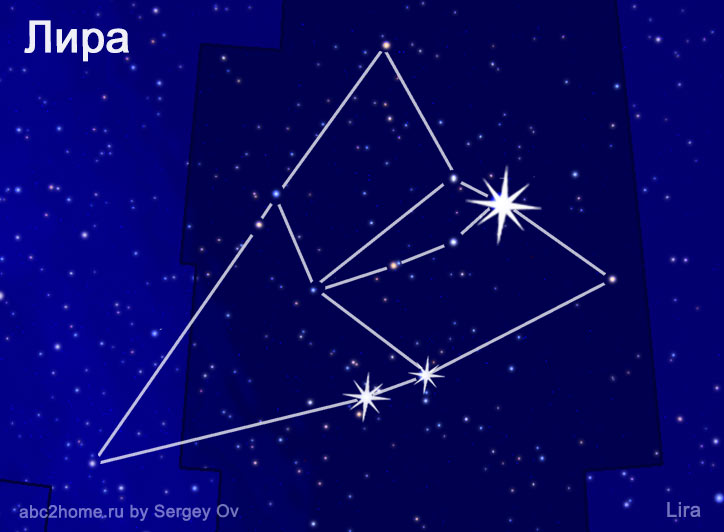 Lyra constellation
Lyra constellation
Fig. 1.Lyr. Lyra constellation, diagram
The constellation Lyra at the latitudes of Central Russia and further north can be observed all year round. The best time to get acquainted with the constellation Lyra is from June to October, when the constellation is near zenith in the evening.
1. As a rule, the constellation Lyra is found by its brightest star Vega, since it is the second brightest star in the Northern Hemisphere of the sky - we find the brightest white star and using simple asterisms (Fig. 16.Lyr) we check: "Is this Vega?"
2. In the summer, almost the entire evening, until midnight, Vega's competitor is present in the sky - Arcturus (Alpha Bootes, α Boo, -0,05m, orange),which ranks first in brightness in the northern part of the sky. Arcturus, however, is not much brighter than Vega, but benefits from the fact that his orange-yellow light is less scattered when passing through the haze. When Vega and Arcturus are together in the sky, it will not be difficult to distinguish between them, if you apply the rule: From Vega to Arcturus you need to move counterclockwise, coming from the pole, while Arcturus is noticeably farther from the pole than Vega.
In winter, the brightest blue and white Sirius dominates in the southern part of the evening sky (Alpha Canis Major, star number one in brightness), Vega hides from him on the opposite northern side almost at the horizon, and Arcturus does not want to see him at all and leaves in advance for the edge of the earth.
3. It should be noted that Vega never goes beyond the horizon for observers located north of the latitudinal line "London - Dortmundt - Leipzig - Kursk - Voronezh - Saratov - Orenburg - Pavlodar - Ulan-Ude - Chita". For southerners, who may not have Vega at all in the starry sky, the search for Lyra with the help of other constellations becomes an urgent topic (Fig.19.Lyr):
Figure: 19.Lyr. How to find the constellation Lyra using the constellations Pegasus, Cygnus, Cassiopeia, Ursa Minor and Hercules
(When copying a figure, please keep its numbering from the original article Fig.19.Lyr - "Constellation Lyra", a link to the original is required.)
Unfortunately, an accurate direct sight directly at Vega from the bright stars of well-known constellations does not work. Although, two hits were still found.
The first hit in Lyra is obtained using the stars of two constellations, Pegasus and Cygnus: We draw the line Scheat (β Peg, 2.44m, red) - Sadr (γ Cyg, 2,23m, white-yellow) and on its continuation we find Vega (yellow arrow in Figures 19.Lyr и 20.Lyr).
The second hit in Vega is obtained by aiming at not very bright stars of the third and fourth magnitude Rutilikus (ζ Her, 2.81m, white-yellow) - Rukbalgeti Genubi (θ Her, 3.86m, orange) of the not very popular constellation Hercules (red arrow, Fig. 19.Lyr).
The main points of departure for the search for Lyra are the constellations Ursa Minor and Cassiopeia. but it should be borne in mind that already at the latitude of Vladivostok and Sochi, the constellation Cassiopeia becomes partially setting.
4. For observers located south of the 44th parallel, the only all-season search algorithm for the constellation Lyra is the search from Ursa Minor.
In order to find the constellation Lyra, based on the stars of the Small Dipper, one has to use a not quite simple three-way search algorithm.
The first step is to find the brightest star in the constellation Dragon - Eltanin (Etamin, 2.24m, orange) and remember its position, for this we draw a line along the side of the Small Dipper closest to the handle from Alifa Al Farkadin (ζ UMi, 4.29m, white) to Alasso (η UMi, 4.95m, white-yellow) and further to Eltanin (blue arrow).
Next, using the stars on the other side of the Small Dipper, Kohab (β UMi, 2.07m, orange) and Ferkad (γ UMi, 3.00m, white), draw a line to the second brightest Dragon star Athebyne (η Dra, 2.73m,yellow), and from Athebyne to Eltanin and further we draw a third line, which at a distance equal to the distance between these stars comes to Delta Lyra (δ2 Lyr, 4.22m, red) - these steps in Figure 19.Lyr are indicated by blue arrows.
If suddenly the second blue arrow leads beyond the horizon, then you are located south of 44 ° north latitude.
5. The second most important algorithm for searching for Lyra stars, shown in Fig. 19.Lyr, is the aiming scheme from the constellation Cassiopeia.
The triple aiming scheme begins with the stars Achird (η Cas, 3,46m, yellow) and Caph (β Cas, 2,28m, white-yellow), mentally continuing the line (green) beyond the constellation Cassiopeia, we come to, similar to Achird, Zeta Cepheus (ζ Cep, 3,39m, orange), following this line of sight further, we approach Fawaris from Cygnus (δ Cyg, 2,86m, blue-white) and retarget it, extrapolating the line further, we come to Sheliak (β Lyr A, 3.52m, white), the third brightest star in the constellation Vega (green arrow in Figure 19.Lyr).
Figure 19.Lyr, covering almost a quarter of the visible part of the starry sky, allows us to estimate the scale of the search, but because of the many arrows it resembles a map of hostilities, Hercules looks especially belligerent with his Rukbalgeti Genubi (θ Her).
The bright stars of W-Asterism Cassiopeia guarantee higher reliability of search methods based on it, so the following two figures illustrate how to find the constellation Lyra, starting from Cassiopeia.
Рис. 20.Lyr. How to find the constellation Lyra using the stars of the constellations Cassiopeia, Pegasus and Cygnus
(When copying a figure, please keep the numbering of the original article - fig.20.Lyr, "Constellation Lyra", reference to the original is required)
Figure 20.Lyr shows on a larger scale the already presented methods of sighting at Lyrae stars: "Sheat - Sadr - Vega (yellow line)" and "Achird - Kaf - Delta Lyra, δ2 Lyr", (green line). As you can see, the scheme of the first method itself does not raise questions.
The second diagram requires clarification: If you keep the line of sight Achird - Caph strictly straight, without being distracted by Zeta Cepheus and Fawaris, then in the constellation Lyra we will get not to Sheliak, but to Delta Lyra. Keep in mind that this range of hits is possible due to the aiming range.
Probably, someone still had a question: "What does the sighting from Scheat from Pegasus have to do with the search from Cassiopeia?"
The fact is that Scheat can also be easily found using the stars of Cassiopeia (Fig. 21.Lyr):
Рис. 21.Lyr. How to find the constellation Lyra using the stars of the constellations Cassiopeia and Pegasus
(When copying a figure, please keep the numbering of the original article - fig.21.Lyr, "Constellation Lyra", reference to the original is required.)
6. If you mentally draw a line through Segin (ε Cas, 3,35m, бело-голубая) blue-white) and Schedar (α Cas, 2,24m, orange) and pave the vector further, then the arrow will rest against the star Sheat (red arrow). Sighting from Scheat (β Peg, 2.44m, red) to Matar (η Peg, 2.93m, yellow) allows you to get close to the pair of stars Sulafat and Sheliak, next in brightness after Vega (the orange arrow mostly points to Sheliak).
Thus, there were at least 6 ways to "identify" the constellation Lyra, for almost all occasions.
Now it remains only to correctly determine the angular dimensions of the constellation Lyra. In Figure 22.Lyr, the constellation is shown in the position that it can be seen overhead on a summer or autumn evening, facing south or southwest.
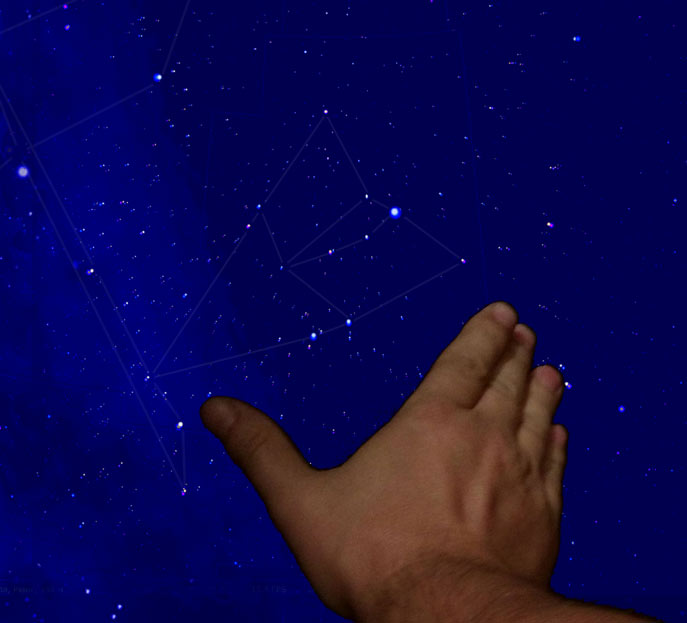
Рис. 22.Lyr. Estimating the angular size of the constellation Lyra using an outstretched arm
(When copying a figure, please keep the numbering of the original article - fig.22.Lyr, "Constellation Lyra", reference to the original is required.)
The angular size of Taurus can be estimated based on the results of calculations of the angular distance between the stars of the constellation, for example, the angular distance from the star Vega to the second brightest star Sulafat is 7.55°(The angular distance between the stars - online calculation), and the angular distance between the eastern and western boundaries the constellation on the shortest line through Vega is 14.4 °.
Another simpler way to estimate angular distances is with an outstretched arm.
The angular distance between the thumb and forefinger of an outstretched hand of a person of normal constitution is 16-18 ° (regardless of gender and age from 7 years old. Lyra's stars against the background of an outstretched hand will look approximately as shown in Figure 21.Lyr. By the way, using the base of the Big Square, you can calibrate the angular size of your own hand), since the angular distance between the stars Algenib (γ Peg) and Macrab (α Peg) is 16.5 °.
Sergey Ov (Seosnews9): The constellation Lyra (Lyr) is the most multifaceted constellation Hercules's family
Constellation finding guide
How to find a constellation? - step-by-step algorithm.
How to find the constellation Ursa Major
How to find the constellation Ursa Minor
How to find the constellation Cassiopeia
How to find the constellation Cygnus
How to find the constellation Boötes
How to find the constellation Orion
How to find the Virgo constellation
How to find the constellation Aries
How to find the constellation Taurus
How to find the constellation Lyra
How to find the constellation Aquila
How to find the constellation Sagittarius
This list of ways to search for constellations is gradually expanding ...
1. The Zodiac includes constellations, after which the zodiac signs are named , with the exception of the constellation Libra, which, on the contrary, was created in accordance with the zodiac sign, mainly due to the stars of the constellation Scorpio. The following constellations are included in the Zodiac family: Leo, Virgo, Libra, Scorpius, Sagittarius, Capricornus, Aquarius, Pisces, Aries, Taurus, Gemini, and Cancer.
2. We will refer the constellations to the Hercules group:
Cygnus, Lyra, Hercules, Vulcepula, Sagitta, Aquila, Scutum, Serpens, Ophiuchus.
Fig. 16.Her. Hercules Family of constellations
●Home
 Zodiac signs
Zodiac signs
 Constellations
✔ How to find Lyra constellation
Constellations
✔ How to find Lyra constellation


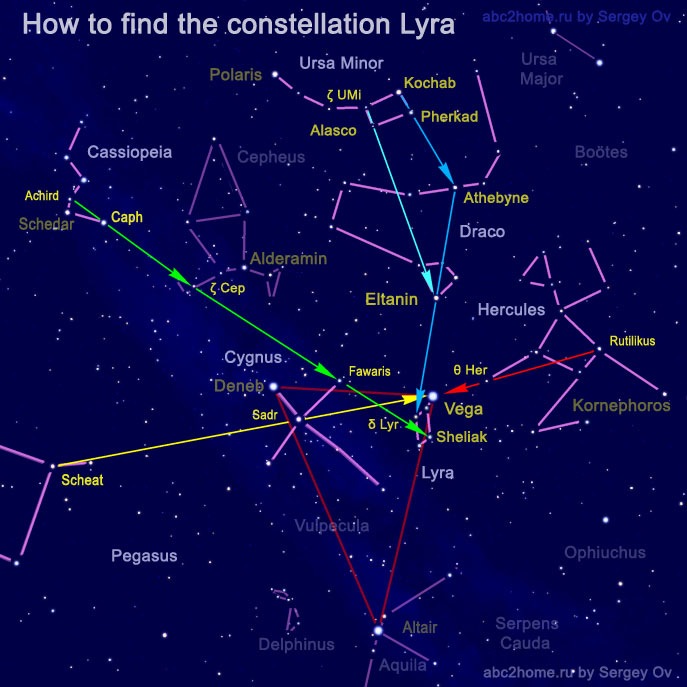
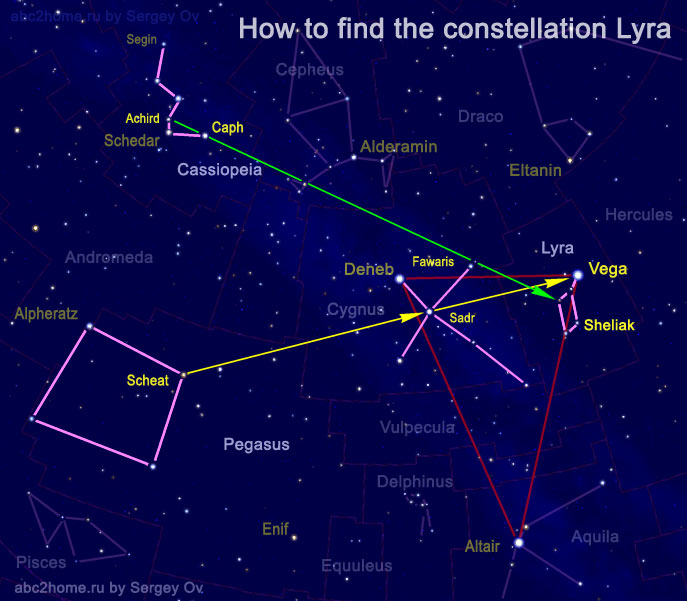
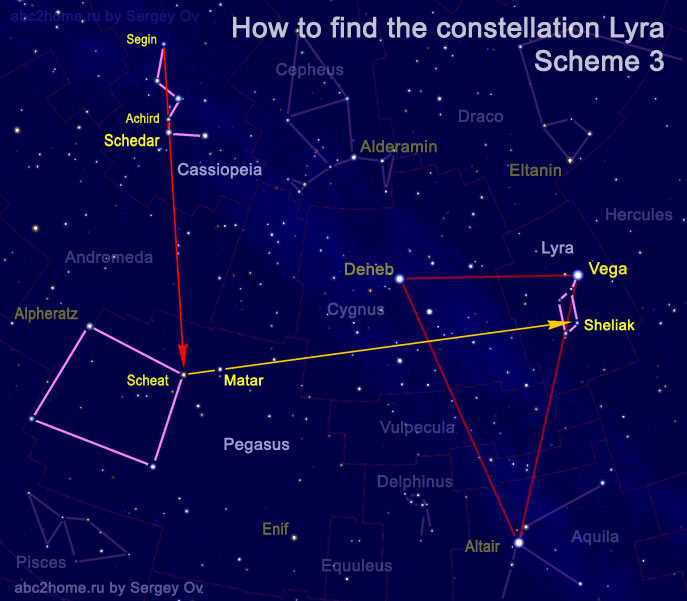
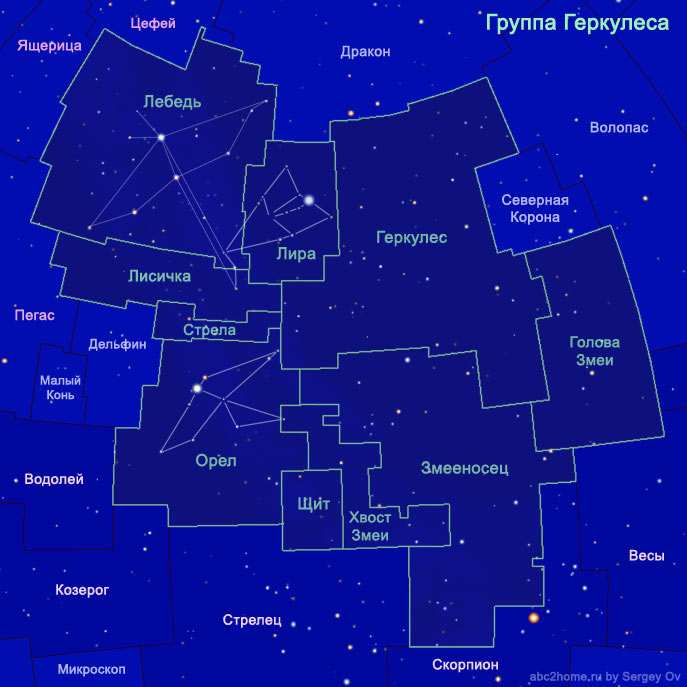
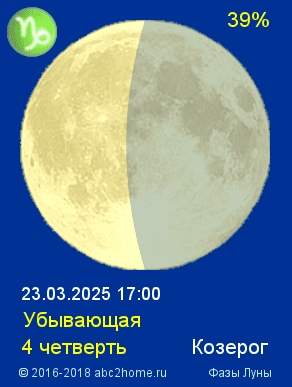


 SIGN ARIES
SIGN ARIES